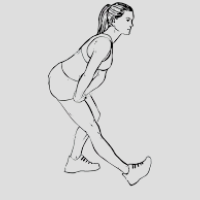
According to a study, 60% of adults say they’ve experienced leg cramps at night and more common in the summer. Some researchers believe that our modern lifestyle is to blame. Your food intake, meds, or standing habits may also play a role.
The following health conditions are associated with an increase in leg cramping: pregnancy, diabetes, hypertension, arthritis, respiratory disease, MS depression, and artery disease.
Diuretic medications to lower blood pressure may trigger cramps because they deplete the body of fluid and salts. Other medications that can trigger leg cramps are asthma medication, synthetic and bio-identical estrogen hormone medication, and statins.
If your leg cramps are spontaneous and not exercise-related, it’s essential to see your doctor to rule out underlying concerns since cholesterol clogs blood vessels in the legs affecting blood flow. Hypothyroidism produces little amount of the thyroid hormone, and that deficiency can damage nerves that send signals from your spine and brain to your legs and arms. Some people with underactive thyroids will feel tingling or numbness in their muscles, while others might experience leg cramps.
For your diet, it’s best to monitor if you are overeating potassium because you can develop an overload leading to an imbalance of minerals and vitamins, causing leg cramps.
What’s the answer?
Do some stretching. Did you know that hamstring and calf stretch exercises just before bed may yield a 59% drop in spasm frequency?
Increase your magnesium with green leafy vegetables, beans, and nuts. Potassium is an electrolyte and a vital mineral for your body.
It helps maintain healthy blood pressure, transports nutrients into your cells, and supports healthy nerve and muscle function. Enjoy foods like avocado, sweet potato, spinach, watermelon, coconut water, white beans, black beans, butternut squash, dried apricots, swiss chard, beets, and pomegranates.
In the summertime, people tend to exercise and sweat more than in winter. So dehydration or physical activity could also trigger leg cramps. It’s imperative to remember to stretch before and after exercising or physical activity. Drink more water and add some electrolytes to the drink while staying away from artificial coloring and sweeteners.
Explore taking a Vitamin B Complex since it may help. Another fascinating fact is that nerve growth and repair might be more active in summer because of the higher vitamin D levels you absorb from the sun. When your Vitamin D levels are the highest, your body may engage in accelerated neural repair, which could trigger these cramps.
If the cramp is in your foot or lower leg, then try a standing calf stretch. If the pain is in your upper leg, hamstring stretches may help. Here’s to you, preventing those painful leg cramps with adequate nutrition, hydration, and stretching.
Watch to learn more about the causes and natural remedies to prevent leg cramping. If you want to reduce your inflammation, boost your immune system, learn natural ways to weight loss and optimize your health, listen now, ✅ Subscribe to this YouTube Channel to gain insight into boosting your health.
Be Happy! Make Healthy Choices today and Stay Healthy!
Grab my book Healthy Living Everyday on Amazon and get started!
Healthy Living Everyday your wellness blueprint book offering an array of alternative healing and preventive therapies, with more than 365 pages of reflective questions, empowering truth, and simple steps covering many alternative factors to wellness.

Tags: cramps, healthy living, leg cramps, magnesium, Nancy Guberti
Leave A Reply (No comments So Far)
No comments yet